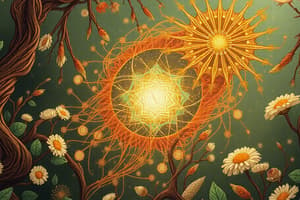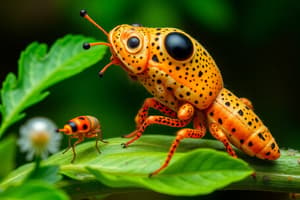Podcast
Questions and Answers
What defines a species in the biological concept?
What defines a species in the biological concept?
- Organisms that have similar morphological characteristics.
- A group of interbreeding populations that are isolated from other groups. (correct)
- Any group of organisms that can adapt to their environment.
- Species that exhibit convergent evolution.
Which of the following is NOT a type of species concept?
Which of the following is NOT a type of species concept?
- Biological
- Theoretical (correct)
- Morphological
- Ecological
What is an example of convergent evolution?
What is an example of convergent evolution?
- Cactus and Euphorbia developing similar adaptations. (correct)
- Different species evolving from a common ancestor.
- Lion and tiger developing similar hunting strategies.
- Two species becoming genetically isolated from each other.
Which term describes the change in species composition of an ecosystem over time?
Which term describes the change in species composition of an ecosystem over time?
What is co-evolution primarily associated with?
What is co-evolution primarily associated with?
What type of organisms are referred to as photoautotrophs?
What type of organisms are referred to as photoautotrophs?
Which of the following best describes the role of herbivores in an ecosystem?
Which of the following best describes the role of herbivores in an ecosystem?
What by-products are typically released when organic compounds decompose or burn?
What by-products are typically released when organic compounds decompose or burn?
Which of the following groups consists of micro-consumers?
Which of the following groups consists of micro-consumers?
What do chemotrophs do in an ecosystem?
What do chemotrophs do in an ecosystem?
In ecological terms, which variable does climate regime NOT refer to?
In ecological terms, which variable does climate regime NOT refer to?
Which category of consumers includes both herbivores and carnivores?
Which category of consumers includes both herbivores and carnivores?
Which of the following statements is true about producers?
Which of the following statements is true about producers?
What is a population in ecological terms?
What is a population in ecological terms?
Which of the following correctly describes primary production?
Which of the following correctly describes primary production?
What best describes resource competition?
What best describes resource competition?
What does the species-area curve illustrate?
What does the species-area curve illustrate?
Which diagram represents the flow of energy through different trophic levels?
Which diagram represents the flow of energy through different trophic levels?
What is the role of a saprotroph in an ecosystem?
What is the role of a saprotroph in an ecosystem?
Which process is characterized by the formation of a new species?
Which process is characterized by the formation of a new species?
How does stabilizing selection affect a population?
How does stabilizing selection affect a population?
What does homeostasis refer to in biological systems?
What does homeostasis refer to in biological systems?
Which cycle describes the transformation of water within the biosphere?
Which cycle describes the transformation of water within the biosphere?
What is the process of illuviation in soil science?
What is the process of illuviation in soil science?
What does the term 'immobilization' refer to in nutrient cycling?
What does the term 'immobilization' refer to in nutrient cycling?
What defines invasive species in a biological context?
What defines invasive species in a biological context?
Which term refers to the study of organism distribution on islands?
Which term refers to the study of organism distribution on islands?
What characterizes a microclimate?
What characterizes a microclimate?
What is the function of microdecomposers in an ecosystem?
What is the function of microdecomposers in an ecosystem?
What does producer respiration represent in an ecosystem?
What does producer respiration represent in an ecosystem?
Which equation correctly demonstrates the relationship according to the first law of thermodynamics?
Which equation correctly demonstrates the relationship according to the first law of thermodynamics?
Net primary production (NPP) can be converted to which of the following components?
Net primary production (NPP) can be converted to which of the following components?
What characterizes the grazing food chain?
What characterizes the grazing food chain?
What is the distinction of a detritus food chain?
What is the distinction of a detritus food chain?
What is a food web?
What is a food web?
Which statement is consistent with the second law of thermodynamics?
Which statement is consistent with the second law of thermodynamics?
How does energy transfer through a food chain primarily occur?
How does energy transfer through a food chain primarily occur?
Flashcards are hidden until you start studying
Study Notes
Homeostasis
- Biological systems resist change to maintain equilibrium.
Hydrological Cycle
- Water continuously cycles through evaporation, cloud formation, precipitation, groundwater storage, runoff, and organismal storage.
- Eventually returning to the ocean.
Illuviation
- Accumulation of soil materials (clay, humus, iron) leached from one layer into another.
Immobilization
- Withholding of energy or nutrients from the organic cycle.
- Opposite of mineralization and mobilization.
Immigration
- Arrival of new individuals into a habitat or population.
Importance Value
- Sum of relative density, dominance, and frequency of a species in a community.
Indigenous Species
- Organisms native to the area
- A subset of indigenous species are endemic.
Interference Competition
- An organism defends a resource, even when it is not in short supply.
Interspecific
- Between individuals of different species.
Intraspecific
- Between individuals of the same species.
Island Biogeography
- Study of organism distribution and community structure on islands.
Lentic
- Still water environments like ponds and lakes.
- Also, organisms living in still water.
Lotic
- Flowing water, like rivers and streams.
Macrodecomposer
- Animals that eat detritus or litter, such as earthworms and termites.
- Also known as a faunal decomposer.
Microclimate
- Climate of small, specific locales.
Microdecomposer
- Actinomycetes, bacteria, and fungi break down detritus or litter using enzymes.
- They reduce it to small organic substances for cell uptake (osmotroph).
- They also break down dead remains (saprotrophs).
- Known as flora decomposers.
Microevolution
- Changes in allele frequencies of a population over time.
Migration
- Shifting of home range, often concerted and directional.
- Occurs due to seasonal or environmental changes.
Moder
- Type of forest humus layer where plant fragments and mineral particles form loose, net-like structures.
- Structures are held together by arthropod droppings.
Population
- Set of organisms of a species living in a locality at a given time.
- A subset of a species within its geographic range.
Predation
- Predator population (A) eats prey population (B).
- Prey population is limited by predation.
Primary Production
- Production of biomass by photosynthetic and chemosynthetic autotrophs (plants).
Producers
- Organisms that produce their own food (autotrophs – self-nourishment).
- Also known as primary producers.
Productivity
- Rate at which a group of organisms produces biomass.
Protocooperation
- Two populations (A and B) benefit from each other, but the relationship is not obligatory.
Pyramid of Energy Flow (Trophic Pyramid)
- Diagram showing energy flow through trophic levels in a food chain or web.
Pyramid of Energy
- Diagrammatic representation of energy flow through different trophic levels.
Pyramid of Numbers
- Diagrammatic representation of the number of individual organisms at each trophic level in an ecosystem.
Reservoir Pool
- Large, slow-moving, biologically inert portion of a biogeochemical cycle.
Resource Competition
- Organisms utilize a common resource that is scarce.
Richness
- Number of diverse species occupying a particular area.
Saprotroph
- Organism that gets energy from non-living organic matter.
Scrub
- Small or low bushes or trees.
Secondary Production
- Production by macroconsumer levels (animals).
Sedimentary Cycles
- Involve phosphorous and other solid nutrients moving from land to the seafloor.
- They return to dry land only through geological uplifting (takes millions of years).
Speciation
- Formation of a new species.
Species
- Group of actually or potentially interbreeding populations that are genetically isolated from other such groups (Mayr, 1971).
Species-Area Curve
- Species richness tends to increase in roomier areas.
Stabilizing Selection
- Mode of selection that counters mutation, gene flow, and genetic drift.
- It preserves the most common phenotypes.
Stochastic Extinction
- Extinction caused by a random environmental event.
Organic Substances
- Complex carbon-based hydrocarbon compounds like glucose (C6H12O6), long-chain hydrocarbons (e.g. carbohydrates, cellulose), small hydrocarbons (pyruvate), amino acids (R-NH3), proteins, nucleic acids (DNA and RNA).
- They decompose or burn, giving off heat, CO2, and H2O.
Climate Regime
- In ecology, refers to atmospheric variables like sunlight, rainfall (precipitation), temperature, humidity, and wind velocity.
Biotic (mode of nourishment)
- Producers: Green plants, photosynthetic bacteria, chemosynthetic bacteria.
- Macro-consumers: Herbivores, carnivores, omnivores, parasitic animals.
- Micro-consumers: Fungi, bacteria, and actinomycetes.
Living (biotic) components
- Producers (autotrophs):
- Photosynthetic Organisms: Green plants (unicellular or multicellular) convert light energy into chemical energy (e.g., glucose) for food (photoautotrophs – light + nourishment).
- Chemosynthetic Organisms: Unicellular organisms (bacteria) break down salts and capture heat into food (chemoautotrophs – chemical + nourishment).
- Consumers (phagotrophs), heterotrophs:
- Usually pass food through a mouth and intestines with undigested material expelled as fecal matter.
- Herbivores: Eat only plant material.
- Carnivores: Eat only animals; secondary and higher-order consumers.
- Omnivores: Eat both animal and plant materials.
Producer Respiration
- Fraction of total food produced that plants use for maintenance, independent of biomass production.
- This energy is not used for biomass production and is essentially waste.
Gross Primary Production (GPP)
- Total food produced by plants.
Net Primary Production (NPP)
- Energy available for transfer to consumers via herbivory and decomposers via litter/mortality.
- NPP is calculated as GPP minus plant respiration (Rs).
Food Chain
- Process of eating and being eaten, transferring energy through the ecosystem.
- Grazing Food Chain: Energy transfer starts with herbivores, feeding on standing plant biomass.
- Detritus Food Chain: Energy transfer starts with microconsumers who feed on dead plant and animal residue (litter).
Food Web
- Interlocking pattern of interconnected food chains.
Concept of Ecosystem Efficiency
- The Flow of Energy: Primary Production to Higher Trophic Levels
- Food chain: Transfer of food energy from one trophic level to the next, linearly until it reaches the terminal consumer.
- Ecosystem Efficiency: How effectively energy is transferred between trophic levels.
Species Biological Concept
- Any group of actually or potentially interbreeding populations that are reproductively isolated from other such groups (Mayr, 1971).
Species Concepts
- Typological/Morphological: Based on physical characteristics.
- Evolutionary: Based on shared ancestry and evolutionary history.
- Genealogical/Phylogenetic: Based on genetic relationships.
- Ecological: Based on ecological roles and interactions.
- Cohesive: Based on the ability of a group to maintain its identity.
- Biological: Based on interbreeding and reproductive isolation.
Population
- A group of organisms of the same species living in a locality at any given time.
Conspecific Populations
- Populations of the same species.
Adaptation
- Any inheritable characteristic that increases an organism's ability to survive and reproduce (natural selection).
Types of Adaptation
- Body parts or structures.
- Colors (camouflage or mimicry).
- Physiological functions (photosynthesis).
Types of Evolution Based on Adaptation
- Convergent Evolution: Independent development of similar adaptations in two species with similar niches (e.g., Cactus and Euphorbia).
- Divergent Evolution: Evolution leading to modifications of basic patterns for different functions (homologous structures), allowing descendants to occupy diverse niches.
Co-evolution
- Species that interact closely may become adapted to one another through a process called co-evolution.
- Can occur as a result of feeding relationships (e.g., Hawk moth and Madagascar star orchid).
Ecological Succession
- Change in species composition of an ecosystem over time.
Studying That Suits You
Use AI to generate personalized quizzes and flashcards to suit your learning preferences.




